Comparative Analysis of Leadership Theories
VerifiedAdded on 2021/03/24
|15
|4938
|62
AI Summary
The provided text is an assignment that requires students to analyze and compare different leadership theories, focusing on transformational and transactional leadership. The assignment includes a list of references from academic journals and books, which suggests that it is part of a larger course or project related to organizational behavior, management, or leadership studies. The student's task is to read the references, identify the key components of each theory, compare and contrast them, and discuss their applications in real-world scenarios.
Contribute Materials
Your contribution can guide someone’s learning journey. Share your
documents today.
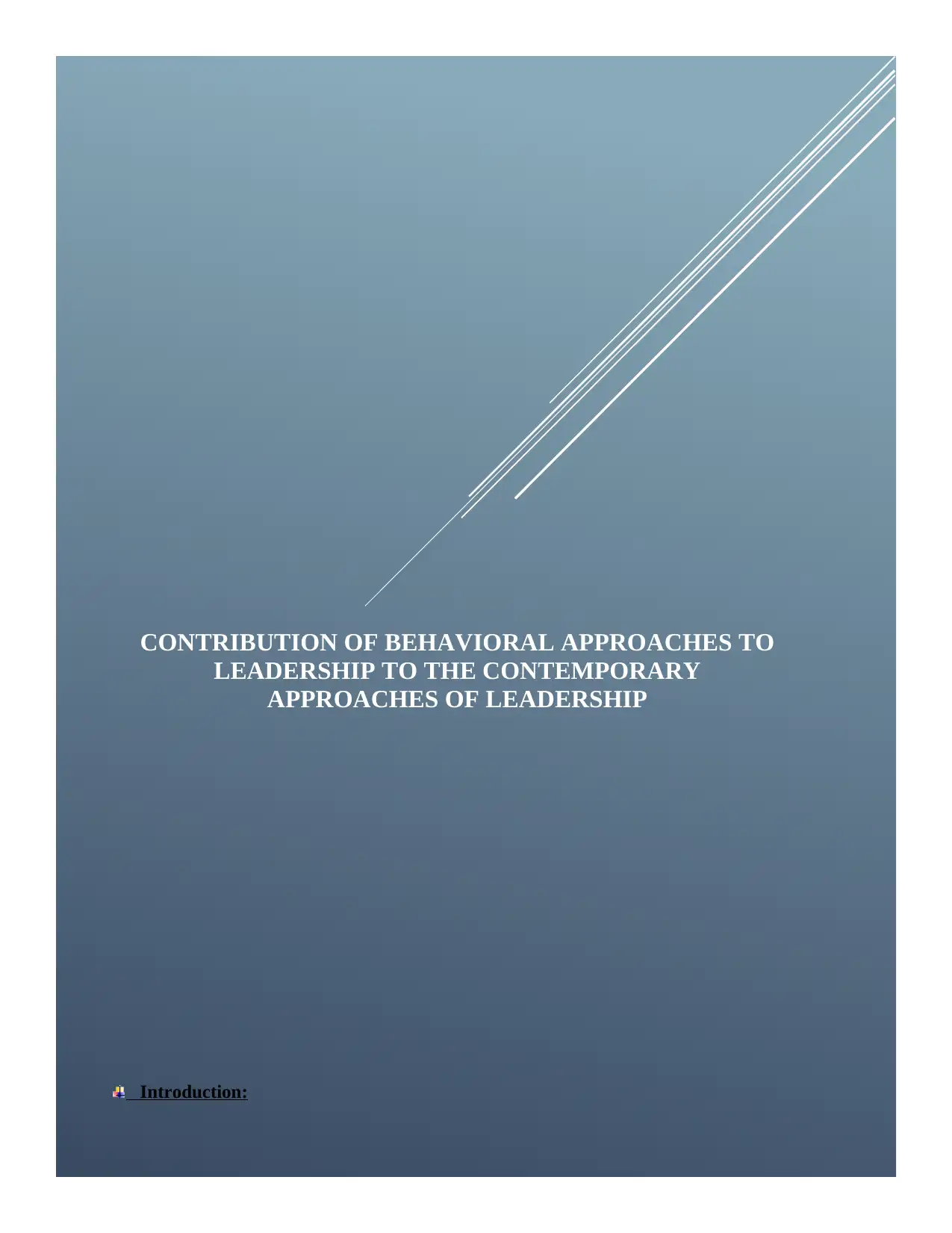
CONTRIBUTION OF BEHAVIORAL APPROACHES TO
LEADERSHIP TO THE CONTEMPORARY
APPROACHES OF LEADERSHIP
Introduction:
LEADERSHIP TO THE CONTEMPORARY
APPROACHES OF LEADERSHIP
Introduction:
Secure Best Marks with AI Grader
Need help grading? Try our AI Grader for instant feedback on your assignments.
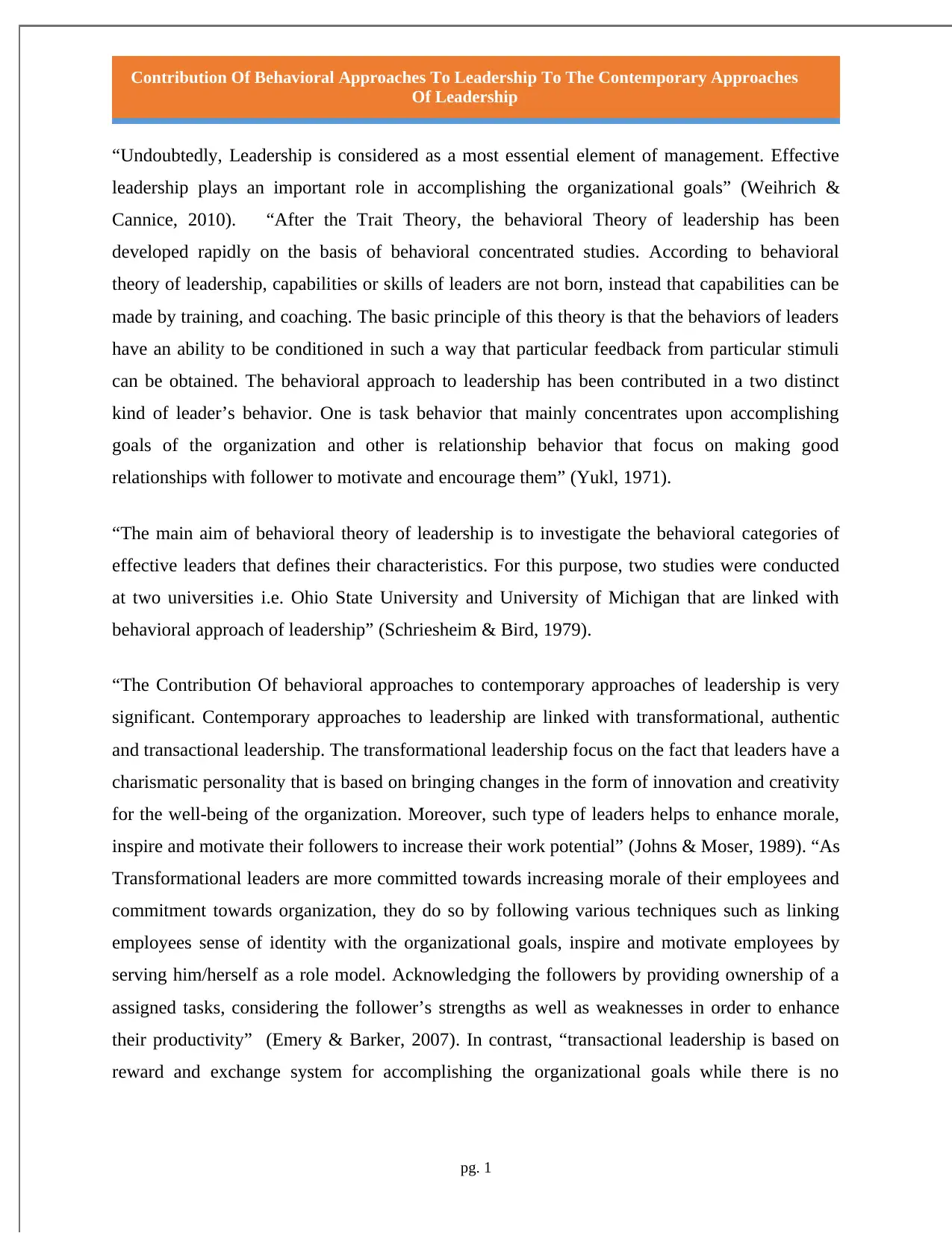
Contribution Of Behavioral Approaches To Leadership To The Contemporary Approaches
Of Leadership
“Undoubtedly, Leadership is considered as a most essential element of management. Effective
leadership plays an important role in accomplishing the organizational goals” (Weihrich &
Cannice, 2010). “After the Trait Theory, the behavioral Theory of leadership has been
developed rapidly on the basis of behavioral concentrated studies. According to behavioral
theory of leadership, capabilities or skills of leaders are not born, instead that capabilities can be
made by training, and coaching. The basic principle of this theory is that the behaviors of leaders
have an ability to be conditioned in such a way that particular feedback from particular stimuli
can be obtained. The behavioral approach to leadership has been contributed in a two distinct
kind of leader’s behavior. One is task behavior that mainly concentrates upon accomplishing
goals of the organization and other is relationship behavior that focus on making good
relationships with follower to motivate and encourage them” (Yukl, 1971).
“The main aim of behavioral theory of leadership is to investigate the behavioral categories of
effective leaders that defines their characteristics. For this purpose, two studies were conducted
at two universities i.e. Ohio State University and University of Michigan that are linked with
behavioral approach of leadership” (Schriesheim & Bird, 1979).
“The Contribution Of behavioral approaches to contemporary approaches of leadership is very
significant. Contemporary approaches to leadership are linked with transformational, authentic
and transactional leadership. The transformational leadership focus on the fact that leaders have a
charismatic personality that is based on bringing changes in the form of innovation and creativity
for the well-being of the organization. Moreover, such type of leaders helps to enhance morale,
inspire and motivate their followers to increase their work potential” (Johns & Moser, 1989). “As
Transformational leaders are more committed towards increasing morale of their employees and
commitment towards organization, they do so by following various techniques such as linking
employees sense of identity with the organizational goals, inspire and motivate employees by
serving him/herself as a role model. Acknowledging the followers by providing ownership of a
assigned tasks, considering the follower’s strengths as well as weaknesses in order to enhance
their productivity” (Emery & Barker, 2007). In contrast, “transactional leadership is based on
reward and exchange system for accomplishing the organizational goals while there is no
pg. 1
Of Leadership
“Undoubtedly, Leadership is considered as a most essential element of management. Effective
leadership plays an important role in accomplishing the organizational goals” (Weihrich &
Cannice, 2010). “After the Trait Theory, the behavioral Theory of leadership has been
developed rapidly on the basis of behavioral concentrated studies. According to behavioral
theory of leadership, capabilities or skills of leaders are not born, instead that capabilities can be
made by training, and coaching. The basic principle of this theory is that the behaviors of leaders
have an ability to be conditioned in such a way that particular feedback from particular stimuli
can be obtained. The behavioral approach to leadership has been contributed in a two distinct
kind of leader’s behavior. One is task behavior that mainly concentrates upon accomplishing
goals of the organization and other is relationship behavior that focus on making good
relationships with follower to motivate and encourage them” (Yukl, 1971).
“The main aim of behavioral theory of leadership is to investigate the behavioral categories of
effective leaders that defines their characteristics. For this purpose, two studies were conducted
at two universities i.e. Ohio State University and University of Michigan that are linked with
behavioral approach of leadership” (Schriesheim & Bird, 1979).
“The Contribution Of behavioral approaches to contemporary approaches of leadership is very
significant. Contemporary approaches to leadership are linked with transformational, authentic
and transactional leadership. The transformational leadership focus on the fact that leaders have a
charismatic personality that is based on bringing changes in the form of innovation and creativity
for the well-being of the organization. Moreover, such type of leaders helps to enhance morale,
inspire and motivate their followers to increase their work potential” (Johns & Moser, 1989). “As
Transformational leaders are more committed towards increasing morale of their employees and
commitment towards organization, they do so by following various techniques such as linking
employees sense of identity with the organizational goals, inspire and motivate employees by
serving him/herself as a role model. Acknowledging the followers by providing ownership of a
assigned tasks, considering the follower’s strengths as well as weaknesses in order to enhance
their productivity” (Emery & Barker, 2007). In contrast, “transactional leadership is based on
reward and exchange system for accomplishing the organizational goals while there is no
pg. 1
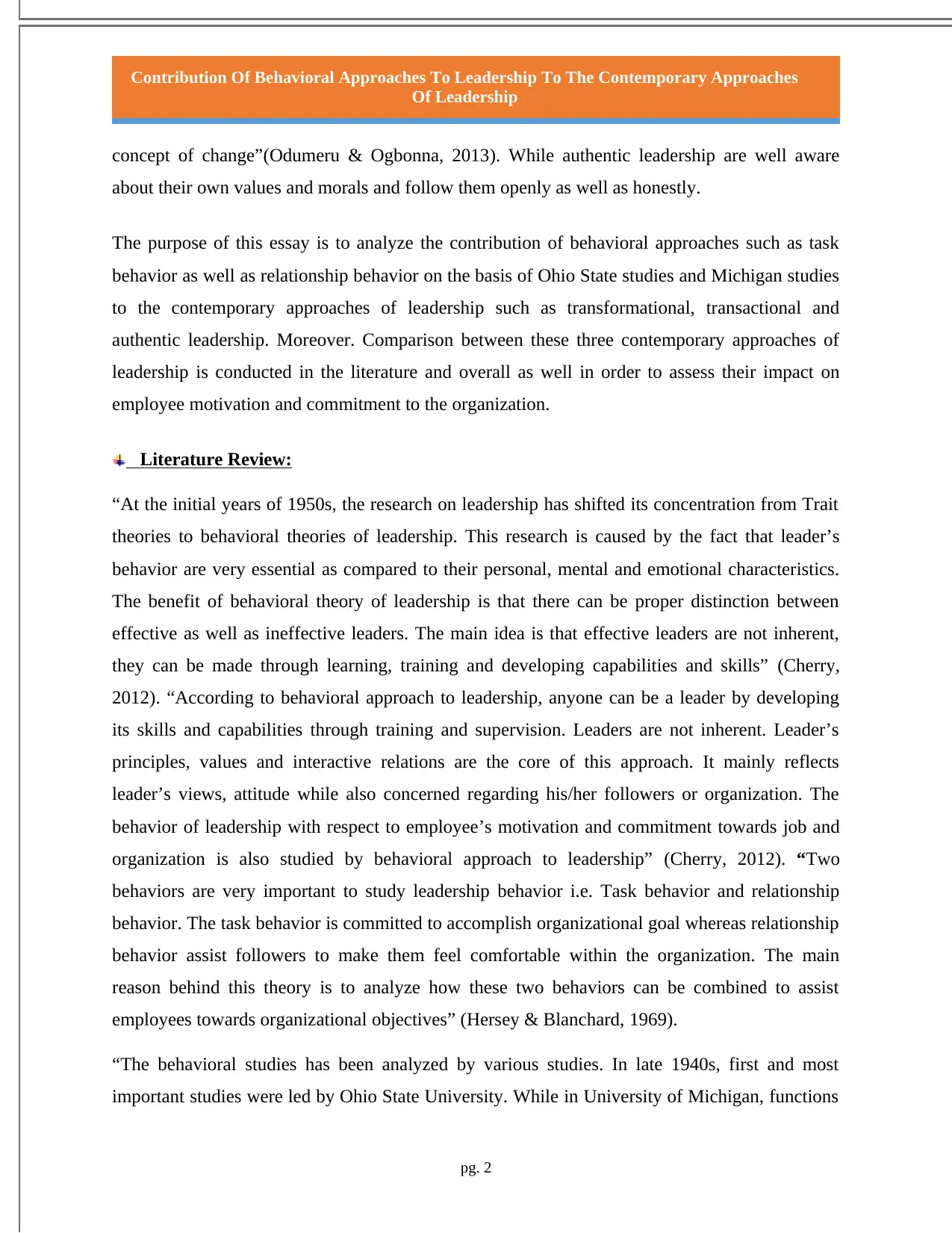
Contribution Of Behavioral Approaches To Leadership To The Contemporary Approaches
Of Leadership
concept of change”(Odumeru & Ogbonna, 2013). While authentic leadership are well aware
about their own values and morals and follow them openly as well as honestly.
The purpose of this essay is to analyze the contribution of behavioral approaches such as task
behavior as well as relationship behavior on the basis of Ohio State studies and Michigan studies
to the contemporary approaches of leadership such as transformational, transactional and
authentic leadership. Moreover. Comparison between these three contemporary approaches of
leadership is conducted in the literature and overall as well in order to assess their impact on
employee motivation and commitment to the organization.
Literature Review:
“At the initial years of 1950s, the research on leadership has shifted its concentration from Trait
theories to behavioral theories of leadership. This research is caused by the fact that leader’s
behavior are very essential as compared to their personal, mental and emotional characteristics.
The benefit of behavioral theory of leadership is that there can be proper distinction between
effective as well as ineffective leaders. The main idea is that effective leaders are not inherent,
they can be made through learning, training and developing capabilities and skills” (Cherry,
2012). “According to behavioral approach to leadership, anyone can be a leader by developing
its skills and capabilities through training and supervision. Leaders are not inherent. Leader’s
principles, values and interactive relations are the core of this approach. It mainly reflects
leader’s views, attitude while also concerned regarding his/her followers or organization. The
behavior of leadership with respect to employee’s motivation and commitment towards job and
organization is also studied by behavioral approach to leadership” (Cherry, 2012). “Two
behaviors are very important to study leadership behavior i.e. Task behavior and relationship
behavior. The task behavior is committed to accomplish organizational goal whereas relationship
behavior assist followers to make them feel comfortable within the organization. The main
reason behind this theory is to analyze how these two behaviors can be combined to assist
employees towards organizational objectives” (Hersey & Blanchard, 1969).
“The behavioral studies has been analyzed by various studies. In late 1940s, first and most
important studies were led by Ohio State University. While in University of Michigan, functions
pg. 2
Of Leadership
concept of change”(Odumeru & Ogbonna, 2013). While authentic leadership are well aware
about their own values and morals and follow them openly as well as honestly.
The purpose of this essay is to analyze the contribution of behavioral approaches such as task
behavior as well as relationship behavior on the basis of Ohio State studies and Michigan studies
to the contemporary approaches of leadership such as transformational, transactional and
authentic leadership. Moreover. Comparison between these three contemporary approaches of
leadership is conducted in the literature and overall as well in order to assess their impact on
employee motivation and commitment to the organization.
Literature Review:
“At the initial years of 1950s, the research on leadership has shifted its concentration from Trait
theories to behavioral theories of leadership. This research is caused by the fact that leader’s
behavior are very essential as compared to their personal, mental and emotional characteristics.
The benefit of behavioral theory of leadership is that there can be proper distinction between
effective as well as ineffective leaders. The main idea is that effective leaders are not inherent,
they can be made through learning, training and developing capabilities and skills” (Cherry,
2012). “According to behavioral approach to leadership, anyone can be a leader by developing
its skills and capabilities through training and supervision. Leaders are not inherent. Leader’s
principles, values and interactive relations are the core of this approach. It mainly reflects
leader’s views, attitude while also concerned regarding his/her followers or organization. The
behavior of leadership with respect to employee’s motivation and commitment towards job and
organization is also studied by behavioral approach to leadership” (Cherry, 2012). “Two
behaviors are very important to study leadership behavior i.e. Task behavior and relationship
behavior. The task behavior is committed to accomplish organizational goal whereas relationship
behavior assist followers to make them feel comfortable within the organization. The main
reason behind this theory is to analyze how these two behaviors can be combined to assist
employees towards organizational objectives” (Hersey & Blanchard, 1969).
“The behavioral studies has been analyzed by various studies. In late 1940s, first and most
important studies were led by Ohio State University. While in University of Michigan, functions
pg. 2
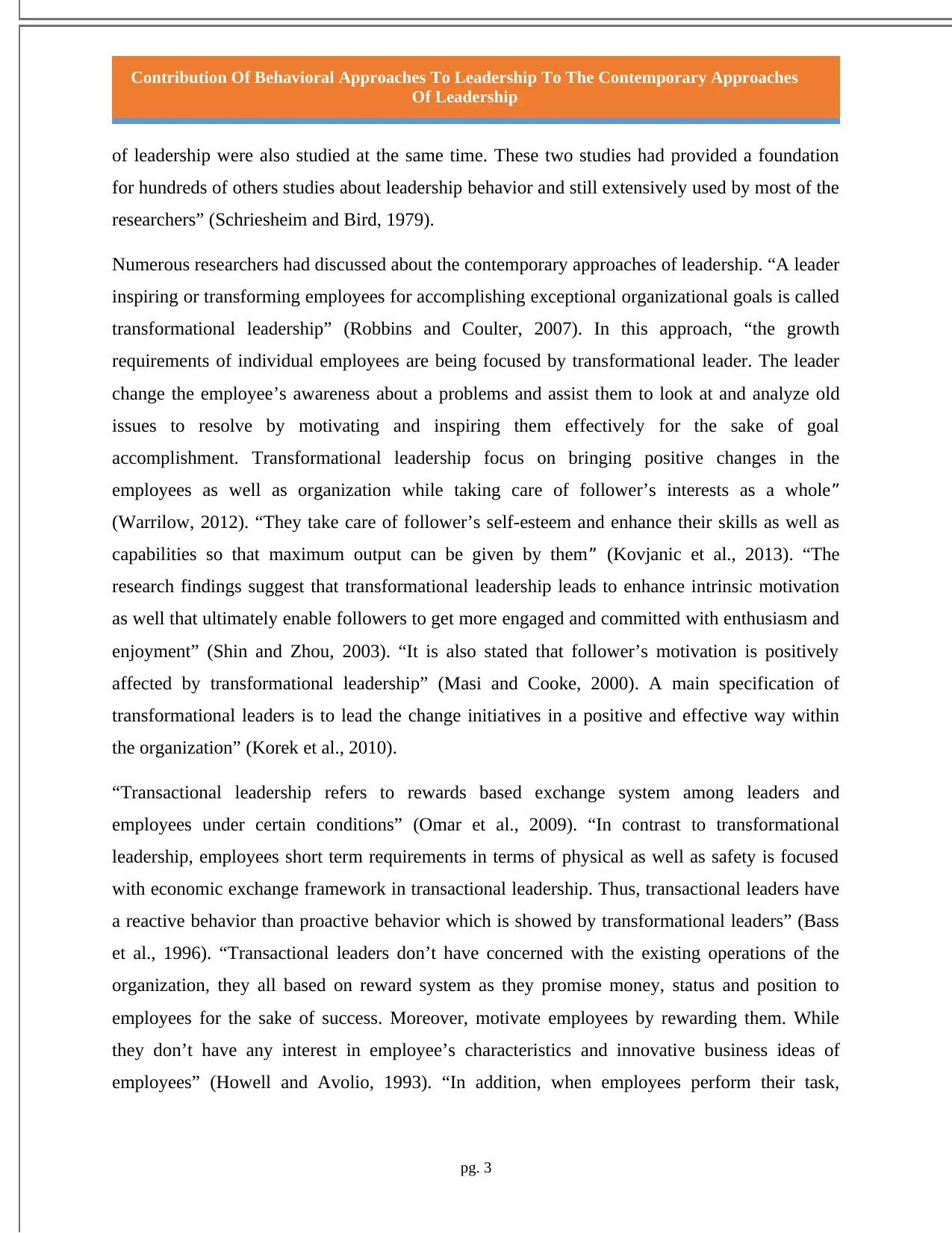
Contribution Of Behavioral Approaches To Leadership To The Contemporary Approaches
Of Leadership
of leadership were also studied at the same time. These two studies had provided a foundation
for hundreds of others studies about leadership behavior and still extensively used by most of the
researchers” (Schriesheim and Bird, 1979).
Numerous researchers had discussed about the contemporary approaches of leadership. “A leader
inspiring or transforming employees for accomplishing exceptional organizational goals is called
transformational leadership” (Robbins and Coulter, 2007). In this approach, “the growth
requirements of individual employees are being focused by transformational leader. The leader
change the employee’s awareness about a problems and assist them to look at and analyze old
issues to resolve by motivating and inspiring them effectively for the sake of goal
accomplishment. Transformational leadership focus on bringing positive changes in the
employees as well as organization while taking care of follower’s interests as a whole”
(Warrilow, 2012). “They take care of follower’s self-esteem and enhance their skills as well as
capabilities so that maximum output can be given by them” (Kovjanic et al., 2013). “The
research findings suggest that transformational leadership leads to enhance intrinsic motivation
as well that ultimately enable followers to get more engaged and committed with enthusiasm and
enjoyment” (Shin and Zhou, 2003). “It is also stated that follower’s motivation is positively
affected by transformational leadership” (Masi and Cooke, 2000). A main specification of
transformational leaders is to lead the change initiatives in a positive and effective way within
the organization” (Korek et al., 2010).
“Transactional leadership refers to rewards based exchange system among leaders and
employees under certain conditions” (Omar et al., 2009). “In contrast to transformational
leadership, employees short term requirements in terms of physical as well as safety is focused
with economic exchange framework in transactional leadership. Thus, transactional leaders have
a reactive behavior than proactive behavior which is showed by transformational leaders” (Bass
et al., 1996). “Transactional leaders don’t have concerned with the existing operations of the
organization, they all based on reward system as they promise money, status and position to
employees for the sake of success. Moreover, motivate employees by rewarding them. While
they don’t have any interest in employee’s characteristics and innovative business ideas of
employees” (Howell and Avolio, 1993). “In addition, when employees perform their task,
pg. 3
Of Leadership
of leadership were also studied at the same time. These two studies had provided a foundation
for hundreds of others studies about leadership behavior and still extensively used by most of the
researchers” (Schriesheim and Bird, 1979).
Numerous researchers had discussed about the contemporary approaches of leadership. “A leader
inspiring or transforming employees for accomplishing exceptional organizational goals is called
transformational leadership” (Robbins and Coulter, 2007). In this approach, “the growth
requirements of individual employees are being focused by transformational leader. The leader
change the employee’s awareness about a problems and assist them to look at and analyze old
issues to resolve by motivating and inspiring them effectively for the sake of goal
accomplishment. Transformational leadership focus on bringing positive changes in the
employees as well as organization while taking care of follower’s interests as a whole”
(Warrilow, 2012). “They take care of follower’s self-esteem and enhance their skills as well as
capabilities so that maximum output can be given by them” (Kovjanic et al., 2013). “The
research findings suggest that transformational leadership leads to enhance intrinsic motivation
as well that ultimately enable followers to get more engaged and committed with enthusiasm and
enjoyment” (Shin and Zhou, 2003). “It is also stated that follower’s motivation is positively
affected by transformational leadership” (Masi and Cooke, 2000). A main specification of
transformational leaders is to lead the change initiatives in a positive and effective way within
the organization” (Korek et al., 2010).
“Transactional leadership refers to rewards based exchange system among leaders and
employees under certain conditions” (Omar et al., 2009). “In contrast to transformational
leadership, employees short term requirements in terms of physical as well as safety is focused
with economic exchange framework in transactional leadership. Thus, transactional leaders have
a reactive behavior than proactive behavior which is showed by transformational leaders” (Bass
et al., 1996). “Transactional leaders don’t have concerned with the existing operations of the
organization, they all based on reward system as they promise money, status and position to
employees for the sake of success. Moreover, motivate employees by rewarding them. While
they don’t have any interest in employee’s characteristics and innovative business ideas of
employees” (Howell and Avolio, 1993). “In addition, when employees perform their task,
pg. 3
Secure Best Marks with AI Grader
Need help grading? Try our AI Grader for instant feedback on your assignments.

Contribution Of Behavioral Approaches To Leadership To The Contemporary Approaches
Of Leadership
transactional leaders rewards them and when tasks are not performed by employees, punishment
is also faced by employees” (Morçin, 2013).
“Authentic leaders have high self-awareness as well as higher self-regulated positive behaviors
that leads to positive self-development” (Wong and Laschinger, 2012). “It depends upon level of
trust as well as transparency” (Müceldili et al., 2013). “The authentic leaders lead and support
their followers on the basis of their own beliefs, values, morals so that beliefs and values of
followers can also be shared” (Yammarino et al., 2008). “As authentic leaders support their
employees and identify each individual separately, consequently employees tends to have high
level of trust on authentic leaders. Thus, transparency is also high. All this lead to motivate
employees towards work task and job commitment positively” (Clapp-Smith et al., 2008).
“Another research also confirmed that the relationship between work engagement and authentic
leadership is positive” (Alok and Israel, 2012). “It is investigated that the authentic leadership
enhance employee’s commitment and job satisfaction very significantly as well” (Darvish et al.,
2011).
“However, authentic leadership is closely related with transformational leadership as it provides
basis for positive leadership” (Banks et al., 2016). There are some following differences found
between transformational leadership, transactional leadership as well as authentic leadership.
“The main distinction is that transformational leadership is all about transforming other on the
basis of strong positive vision with innovative ideas and creativity. They basically focus upon
bringing positive change within the organization to achieve goals. In contrast, authentic leaders
have deep sense of self that is not available in transformational leadership. They know clearly
that who they are, what are their beliefs, values and ethics and lead the follower’s accordingly”
(Avolio and Gardner, 2005). “Unlike transformational and authentic leadership, transactional
leadership is based on monetary rewards and punishment for the organizational goal
accomplishment. Such leaders are not interested in any change initiatives” (Omar et al., 2009).
Comparison Between Authentic, Transactional and Transformational leadership
(Ruggieri, 2009)
Authentic leadership Transactional leadership Transformational leadership
pg. 4
Of Leadership
transactional leaders rewards them and when tasks are not performed by employees, punishment
is also faced by employees” (Morçin, 2013).
“Authentic leaders have high self-awareness as well as higher self-regulated positive behaviors
that leads to positive self-development” (Wong and Laschinger, 2012). “It depends upon level of
trust as well as transparency” (Müceldili et al., 2013). “The authentic leaders lead and support
their followers on the basis of their own beliefs, values, morals so that beliefs and values of
followers can also be shared” (Yammarino et al., 2008). “As authentic leaders support their
employees and identify each individual separately, consequently employees tends to have high
level of trust on authentic leaders. Thus, transparency is also high. All this lead to motivate
employees towards work task and job commitment positively” (Clapp-Smith et al., 2008).
“Another research also confirmed that the relationship between work engagement and authentic
leadership is positive” (Alok and Israel, 2012). “It is investigated that the authentic leadership
enhance employee’s commitment and job satisfaction very significantly as well” (Darvish et al.,
2011).
“However, authentic leadership is closely related with transformational leadership as it provides
basis for positive leadership” (Banks et al., 2016). There are some following differences found
between transformational leadership, transactional leadership as well as authentic leadership.
“The main distinction is that transformational leadership is all about transforming other on the
basis of strong positive vision with innovative ideas and creativity. They basically focus upon
bringing positive change within the organization to achieve goals. In contrast, authentic leaders
have deep sense of self that is not available in transformational leadership. They know clearly
that who they are, what are their beliefs, values and ethics and lead the follower’s accordingly”
(Avolio and Gardner, 2005). “Unlike transformational and authentic leadership, transactional
leadership is based on monetary rewards and punishment for the organizational goal
accomplishment. Such leaders are not interested in any change initiatives” (Omar et al., 2009).
Comparison Between Authentic, Transactional and Transformational leadership
(Ruggieri, 2009)
Authentic leadership Transactional leadership Transformational leadership
pg. 4
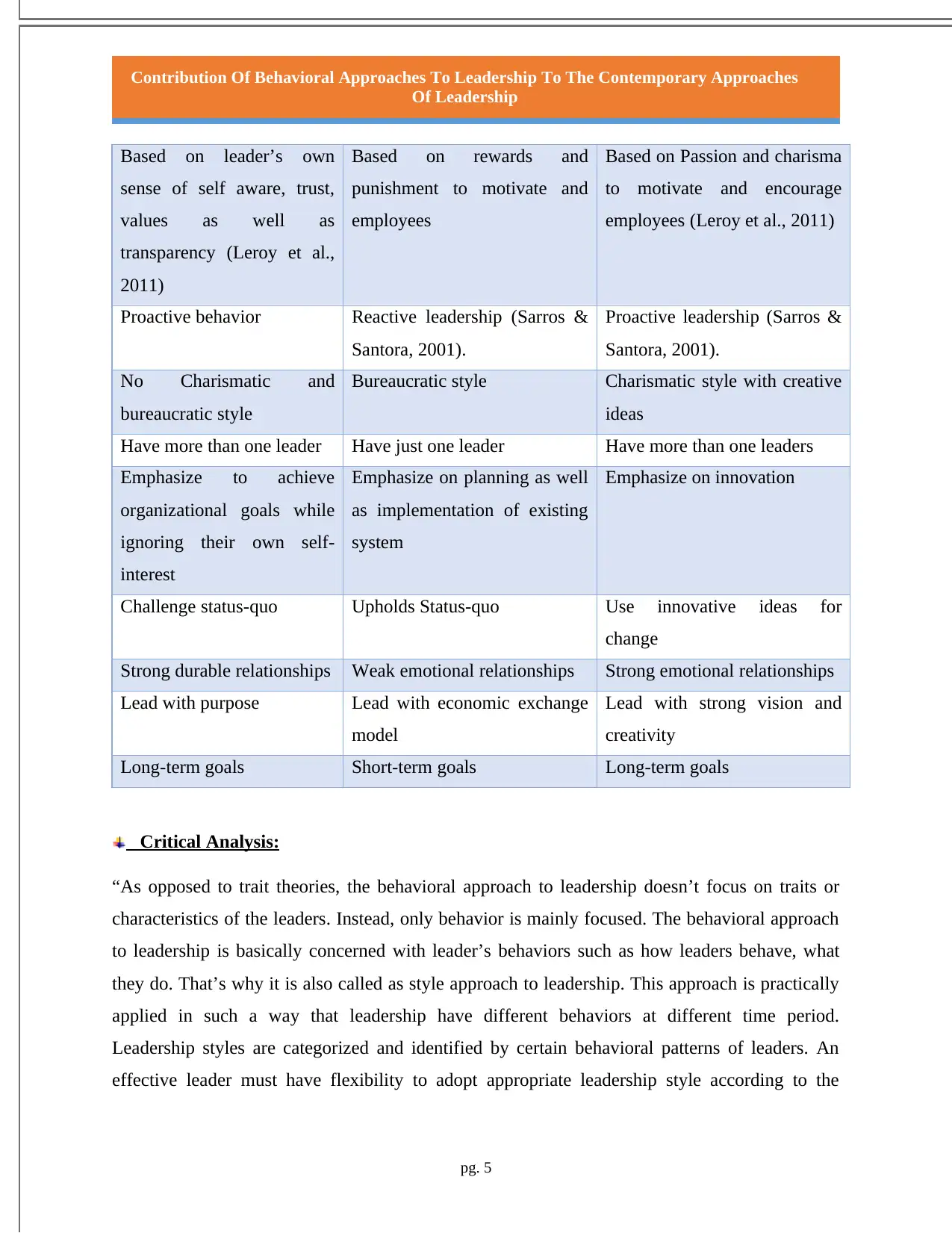
Contribution Of Behavioral Approaches To Leadership To The Contemporary Approaches
Of Leadership
Based on leader’s own
sense of self aware, trust,
values as well as
transparency (Leroy et al.,
2011)
Based on rewards and
punishment to motivate and
employees
Based on Passion and charisma
to motivate and encourage
employees (Leroy et al., 2011)
Proactive behavior Reactive leadership (Sarros &
Santora, 2001).
Proactive leadership (Sarros &
Santora, 2001).
No Charismatic and
bureaucratic style
Bureaucratic style Charismatic style with creative
ideas
Have more than one leader Have just one leader Have more than one leaders
Emphasize to achieve
organizational goals while
ignoring their own self-
interest
Emphasize on planning as well
as implementation of existing
system
Emphasize on innovation
Challenge status-quo Upholds Status-quo Use innovative ideas for
change
Strong durable relationships Weak emotional relationships Strong emotional relationships
Lead with purpose Lead with economic exchange
model
Lead with strong vision and
creativity
Long-term goals Short-term goals Long-term goals
Critical Analysis:
“As opposed to trait theories, the behavioral approach to leadership doesn’t focus on traits or
characteristics of the leaders. Instead, only behavior is mainly focused. The behavioral approach
to leadership is basically concerned with leader’s behaviors such as how leaders behave, what
they do. That’s why it is also called as style approach to leadership. This approach is practically
applied in such a way that leadership have different behaviors at different time period.
Leadership styles are categorized and identified by certain behavioral patterns of leaders. An
effective leader must have flexibility to adopt appropriate leadership style according to the
pg. 5
Of Leadership
Based on leader’s own
sense of self aware, trust,
values as well as
transparency (Leroy et al.,
2011)
Based on rewards and
punishment to motivate and
employees
Based on Passion and charisma
to motivate and encourage
employees (Leroy et al., 2011)
Proactive behavior Reactive leadership (Sarros &
Santora, 2001).
Proactive leadership (Sarros &
Santora, 2001).
No Charismatic and
bureaucratic style
Bureaucratic style Charismatic style with creative
ideas
Have more than one leader Have just one leader Have more than one leaders
Emphasize to achieve
organizational goals while
ignoring their own self-
interest
Emphasize on planning as well
as implementation of existing
system
Emphasize on innovation
Challenge status-quo Upholds Status-quo Use innovative ideas for
change
Strong durable relationships Weak emotional relationships Strong emotional relationships
Lead with purpose Lead with economic exchange
model
Lead with strong vision and
creativity
Long-term goals Short-term goals Long-term goals
Critical Analysis:
“As opposed to trait theories, the behavioral approach to leadership doesn’t focus on traits or
characteristics of the leaders. Instead, only behavior is mainly focused. The behavioral approach
to leadership is basically concerned with leader’s behaviors such as how leaders behave, what
they do. That’s why it is also called as style approach to leadership. This approach is practically
applied in such a way that leadership have different behaviors at different time period.
Leadership styles are categorized and identified by certain behavioral patterns of leaders. An
effective leader must have flexibility to adopt appropriate leadership style according to the
pg. 5
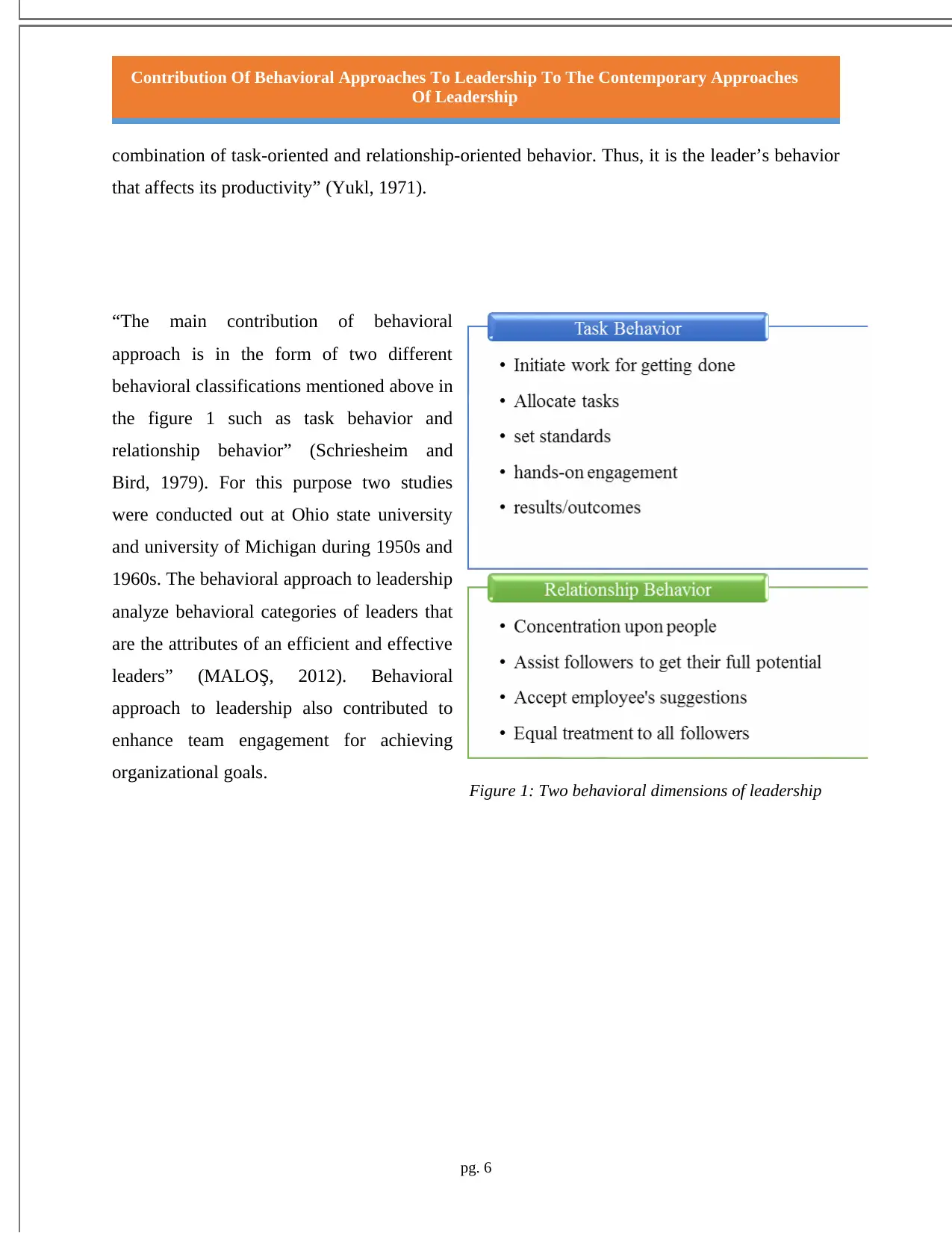
Figure 1: Two behavioral dimensions of leadership
Contribution Of Behavioral Approaches To Leadership To The Contemporary Approaches
Of Leadership
combination of task-oriented and relationship-oriented behavior. Thus, it is the leader’s behavior
that affects its productivity” (Yukl, 1971).
“The main contribution of behavioral
approach is in the form of two different
behavioral classifications mentioned above in
the figure 1 such as task behavior and
relationship behavior” (Schriesheim and
Bird, 1979). For this purpose two studies
were conducted out at Ohio state university
and university of Michigan during 1950s and
1960s. The behavioral approach to leadership
analyze behavioral categories of leaders that
are the attributes of an efficient and effective
leaders” (MALOŞ, 2012). Behavioral
approach to leadership also contributed to
enhance team engagement for achieving
organizational goals.
pg. 6
Contribution Of Behavioral Approaches To Leadership To The Contemporary Approaches
Of Leadership
combination of task-oriented and relationship-oriented behavior. Thus, it is the leader’s behavior
that affects its productivity” (Yukl, 1971).
“The main contribution of behavioral
approach is in the form of two different
behavioral classifications mentioned above in
the figure 1 such as task behavior and
relationship behavior” (Schriesheim and
Bird, 1979). For this purpose two studies
were conducted out at Ohio state university
and university of Michigan during 1950s and
1960s. The behavioral approach to leadership
analyze behavioral categories of leaders that
are the attributes of an efficient and effective
leaders” (MALOŞ, 2012). Behavioral
approach to leadership also contributed to
enhance team engagement for achieving
organizational goals.
pg. 6
Paraphrase This Document
Need a fresh take? Get an instant paraphrase of this document with our AI Paraphraser
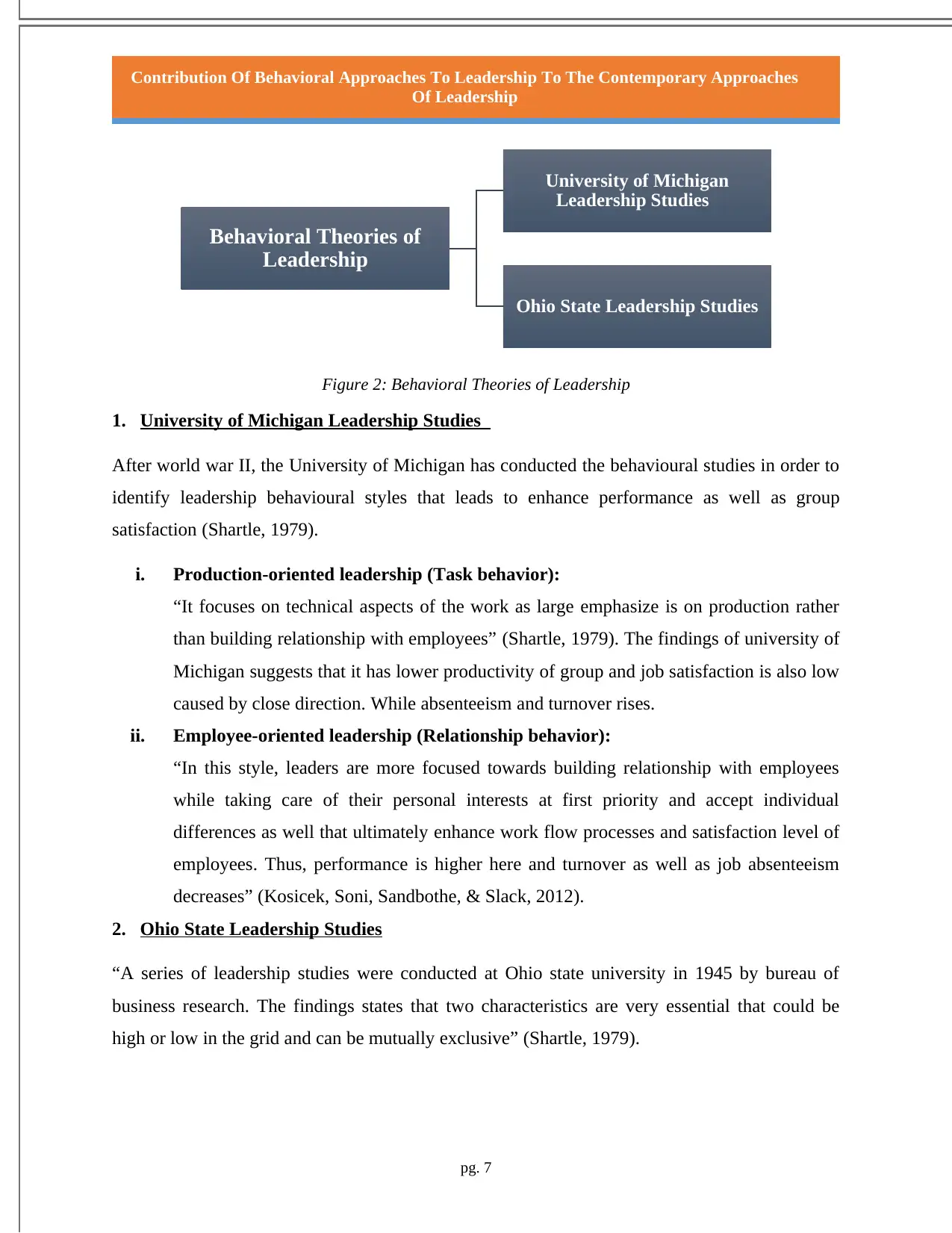
Contribution Of Behavioral Approaches To Leadership To The Contemporary Approaches
Of Leadership
Figure 2: Behavioral Theories of Leadership
1. University of Michigan Leadership Studies
After world war II, the University of Michigan has conducted the behavioural studies in order to
identify leadership behavioural styles that leads to enhance performance as well as group
satisfaction (Shartle, 1979).
i. Production-oriented leadership (Task behavior):
“It focuses on technical aspects of the work as large emphasize is on production rather
than building relationship with employees” (Shartle, 1979). The findings of university of
Michigan suggests that it has lower productivity of group and job satisfaction is also low
caused by close direction. While absenteeism and turnover rises.
ii. Employee-oriented leadership (Relationship behavior):
“In this style, leaders are more focused towards building relationship with employees
while taking care of their personal interests at first priority and accept individual
differences as well that ultimately enhance work flow processes and satisfaction level of
employees. Thus, performance is higher here and turnover as well as job absenteeism
decreases” (Kosicek, Soni, Sandbothe, & Slack, 2012).
2. Ohio State Leadership Studies
“A series of leadership studies were conducted at Ohio state university in 1945 by bureau of
business research. The findings states that two characteristics are very essential that could be
high or low in the grid and can be mutually exclusive” (Shartle, 1979).
pg. 7
Behavioral Theories of
Leadership
University of Michigan
Leadership Studies
Ohio State Leadership Studies
Of Leadership
Figure 2: Behavioral Theories of Leadership
1. University of Michigan Leadership Studies
After world war II, the University of Michigan has conducted the behavioural studies in order to
identify leadership behavioural styles that leads to enhance performance as well as group
satisfaction (Shartle, 1979).
i. Production-oriented leadership (Task behavior):
“It focuses on technical aspects of the work as large emphasize is on production rather
than building relationship with employees” (Shartle, 1979). The findings of university of
Michigan suggests that it has lower productivity of group and job satisfaction is also low
caused by close direction. While absenteeism and turnover rises.
ii. Employee-oriented leadership (Relationship behavior):
“In this style, leaders are more focused towards building relationship with employees
while taking care of their personal interests at first priority and accept individual
differences as well that ultimately enhance work flow processes and satisfaction level of
employees. Thus, performance is higher here and turnover as well as job absenteeism
decreases” (Kosicek, Soni, Sandbothe, & Slack, 2012).
2. Ohio State Leadership Studies
“A series of leadership studies were conducted at Ohio state university in 1945 by bureau of
business research. The findings states that two characteristics are very essential that could be
high or low in the grid and can be mutually exclusive” (Shartle, 1979).
pg. 7
Behavioral Theories of
Leadership
University of Michigan
Leadership Studies
Ohio State Leadership Studies
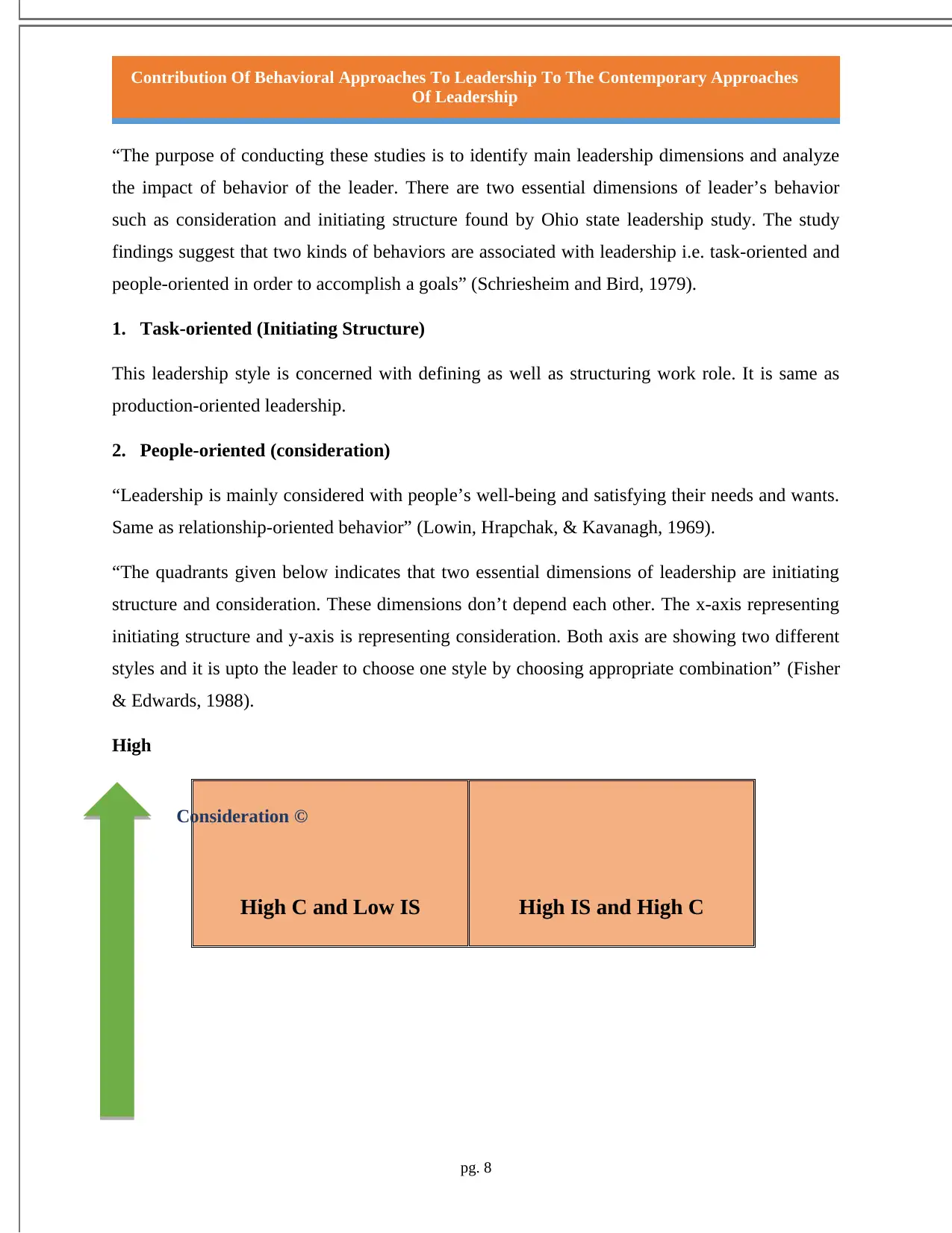
Contribution Of Behavioral Approaches To Leadership To The Contemporary Approaches
Of Leadership
“The purpose of conducting these studies is to identify main leadership dimensions and analyze
the impact of behavior of the leader. There are two essential dimensions of leader’s behavior
such as consideration and initiating structure found by Ohio state leadership study. The study
findings suggest that two kinds of behaviors are associated with leadership i.e. task-oriented and
people-oriented in order to accomplish a goals” (Schriesheim and Bird, 1979).
1. Task-oriented (Initiating Structure)
This leadership style is concerned with defining as well as structuring work role. It is same as
production-oriented leadership.
2. People-oriented (consideration)
“Leadership is mainly considered with people’s well-being and satisfying their needs and wants.
Same as relationship-oriented behavior” (Lowin, Hrapchak, & Kavanagh, 1969).
“The quadrants given below indicates that two essential dimensions of leadership are initiating
structure and consideration. These dimensions don’t depend each other. The x-axis representing
initiating structure and y-axis is representing consideration. Both axis are showing two different
styles and it is upto the leader to choose one style by choosing appropriate combination” (Fisher
& Edwards, 1988).
High
High C and Low IS High IS and High C
pg. 8
Consideration ©
Of Leadership
“The purpose of conducting these studies is to identify main leadership dimensions and analyze
the impact of behavior of the leader. There are two essential dimensions of leader’s behavior
such as consideration and initiating structure found by Ohio state leadership study. The study
findings suggest that two kinds of behaviors are associated with leadership i.e. task-oriented and
people-oriented in order to accomplish a goals” (Schriesheim and Bird, 1979).
1. Task-oriented (Initiating Structure)
This leadership style is concerned with defining as well as structuring work role. It is same as
production-oriented leadership.
2. People-oriented (consideration)
“Leadership is mainly considered with people’s well-being and satisfying their needs and wants.
Same as relationship-oriented behavior” (Lowin, Hrapchak, & Kavanagh, 1969).
“The quadrants given below indicates that two essential dimensions of leadership are initiating
structure and consideration. These dimensions don’t depend each other. The x-axis representing
initiating structure and y-axis is representing consideration. Both axis are showing two different
styles and it is upto the leader to choose one style by choosing appropriate combination” (Fisher
& Edwards, 1988).
High
High C and Low IS High IS and High C
pg. 8
Consideration ©
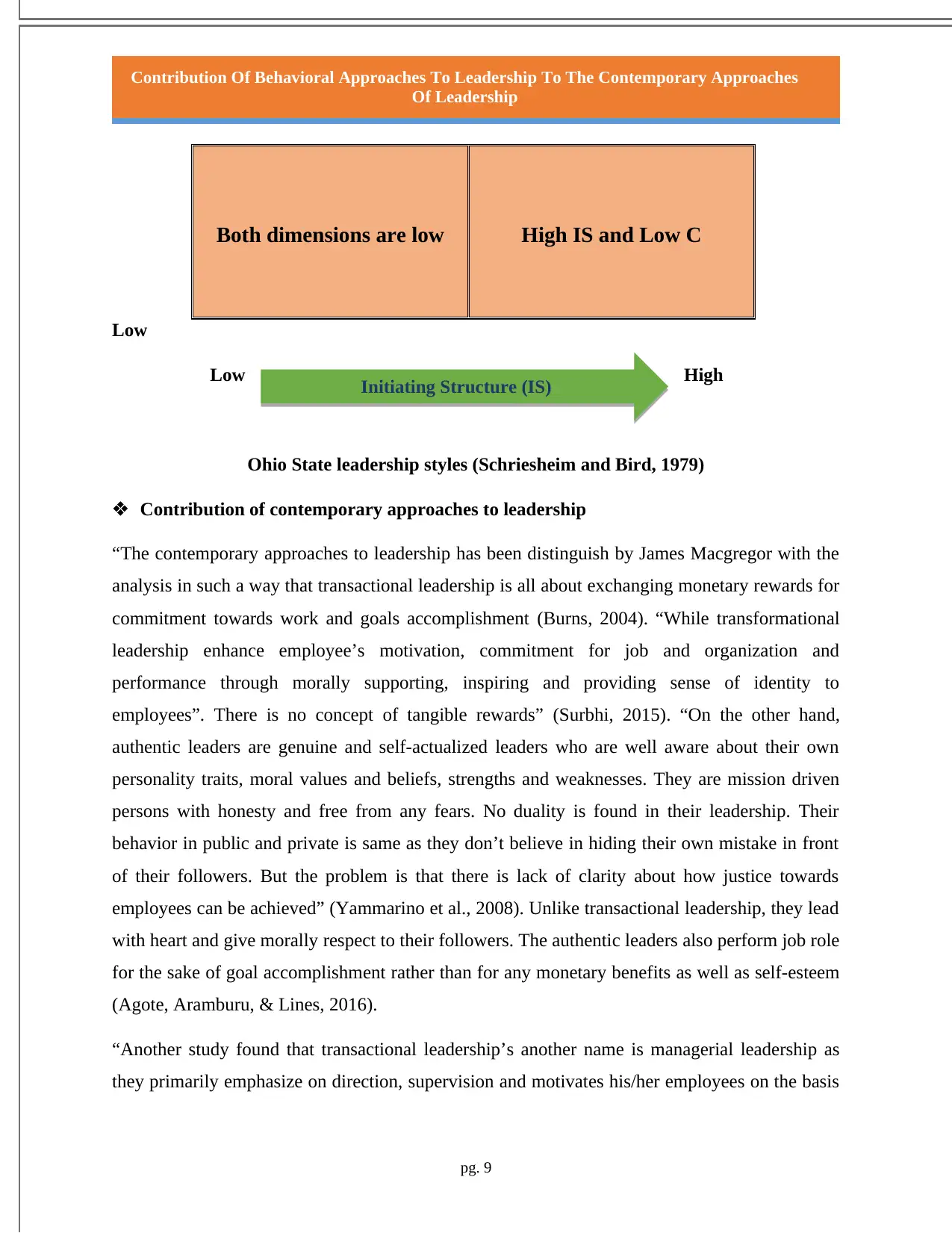
Contribution Of Behavioral Approaches To Leadership To The Contemporary Approaches
Of Leadership
Both dimensions are low High IS and Low C
Low
Low High
Ohio State leadership styles (Schriesheim and Bird, 1979)
Contribution of contemporary approaches to leadership
“The contemporary approaches to leadership has been distinguish by James Macgregor with the
analysis in such a way that transactional leadership is all about exchanging monetary rewards for
commitment towards work and goals accomplishment (Burns, 2004). “While transformational
leadership enhance employee’s motivation, commitment for job and organization and
performance through morally supporting, inspiring and providing sense of identity to
employees”. There is no concept of tangible rewards” (Surbhi, 2015). “On the other hand,
authentic leaders are genuine and self-actualized leaders who are well aware about their own
personality traits, moral values and beliefs, strengths and weaknesses. They are mission driven
persons with honesty and free from any fears. No duality is found in their leadership. Their
behavior in public and private is same as they don’t believe in hiding their own mistake in front
of their followers. But the problem is that there is lack of clarity about how justice towards
employees can be achieved” (Yammarino et al., 2008). Unlike transactional leadership, they lead
with heart and give morally respect to their followers. The authentic leaders also perform job role
for the sake of goal accomplishment rather than for any monetary benefits as well as self-esteem
(Agote, Aramburu, & Lines, 2016).
“Another study found that transactional leadership’s another name is managerial leadership as
they primarily emphasize on direction, supervision and motivates his/her employees on the basis
pg. 9
Initiating Structure (IS)
Of Leadership
Both dimensions are low High IS and Low C
Low
Low High
Ohio State leadership styles (Schriesheim and Bird, 1979)
Contribution of contemporary approaches to leadership
“The contemporary approaches to leadership has been distinguish by James Macgregor with the
analysis in such a way that transactional leadership is all about exchanging monetary rewards for
commitment towards work and goals accomplishment (Burns, 2004). “While transformational
leadership enhance employee’s motivation, commitment for job and organization and
performance through morally supporting, inspiring and providing sense of identity to
employees”. There is no concept of tangible rewards” (Surbhi, 2015). “On the other hand,
authentic leaders are genuine and self-actualized leaders who are well aware about their own
personality traits, moral values and beliefs, strengths and weaknesses. They are mission driven
persons with honesty and free from any fears. No duality is found in their leadership. Their
behavior in public and private is same as they don’t believe in hiding their own mistake in front
of their followers. But the problem is that there is lack of clarity about how justice towards
employees can be achieved” (Yammarino et al., 2008). Unlike transactional leadership, they lead
with heart and give morally respect to their followers. The authentic leaders also perform job role
for the sake of goal accomplishment rather than for any monetary benefits as well as self-esteem
(Agote, Aramburu, & Lines, 2016).
“Another study found that transactional leadership’s another name is managerial leadership as
they primarily emphasize on direction, supervision and motivates his/her employees on the basis
pg. 9
Initiating Structure (IS)
Secure Best Marks with AI Grader
Need help grading? Try our AI Grader for instant feedback on your assignments.
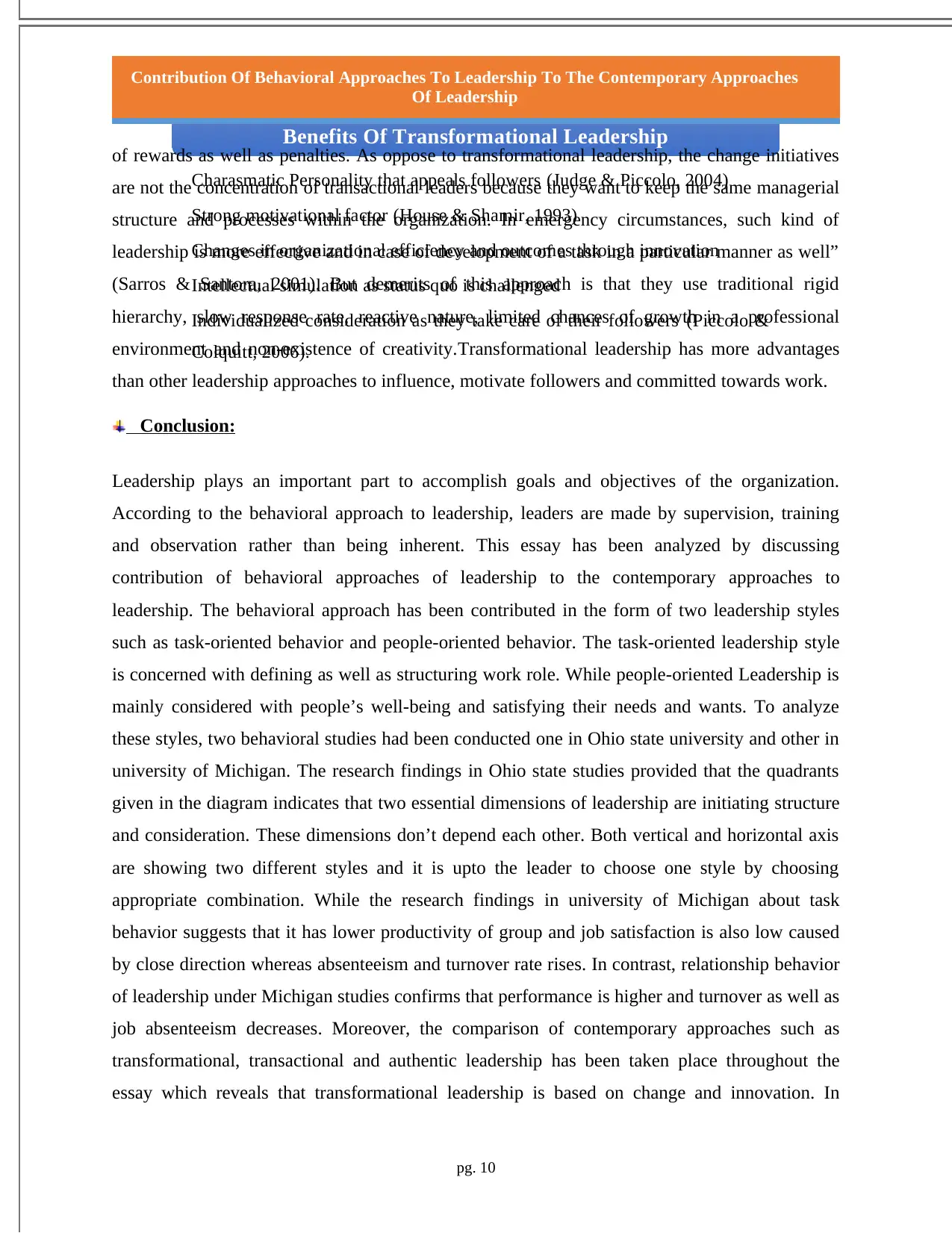
Benefits Of Transformational Leadership
Charasmatic Personality that appeals followers (Judge & Piccolo, 2004)
Strong motivational factor (House & Shamir, 1993)
Changes in organizational efficiency and outcomes through innovation
Intellectual simulation as status quo is challenged
Individualized consideration as they take care of their followers (Piccolo &
Colquitt, 2006).
Contribution Of Behavioral Approaches To Leadership To The Contemporary Approaches
Of Leadership
of rewards as well as penalties. As oppose to transformational leadership, the change initiatives
are not the concentration of transactional leaders because they want to keep the same managerial
structure and processes within the organization. In emergency circumstances, such kind of
leadership is more effective and in case of development of a task in a particular manner as well”
(Sarros & Santora, 2001). But demerits of this approach is that they use traditional rigid
hierarchy, slow response rate, reactive nature, limited chances of growth in a professional
environment and non-existence of creativity.Transformational leadership has more advantages
than other leadership approaches to influence, motivate followers and committed towards work.
Conclusion:
Leadership plays an important part to accomplish goals and objectives of the organization.
According to the behavioral approach to leadership, leaders are made by supervision, training
and observation rather than being inherent. This essay has been analyzed by discussing
contribution of behavioral approaches of leadership to the contemporary approaches to
leadership. The behavioral approach has been contributed in the form of two leadership styles
such as task-oriented behavior and people-oriented behavior. The task-oriented leadership style
is concerned with defining as well as structuring work role. While people-oriented Leadership is
mainly considered with people’s well-being and satisfying their needs and wants. To analyze
these styles, two behavioral studies had been conducted one in Ohio state university and other in
university of Michigan. The research findings in Ohio state studies provided that the quadrants
given in the diagram indicates that two essential dimensions of leadership are initiating structure
and consideration. These dimensions don’t depend each other. Both vertical and horizontal axis
are showing two different styles and it is upto the leader to choose one style by choosing
appropriate combination. While the research findings in university of Michigan about task
behavior suggests that it has lower productivity of group and job satisfaction is also low caused
by close direction whereas absenteeism and turnover rate rises. In contrast, relationship behavior
of leadership under Michigan studies confirms that performance is higher and turnover as well as
job absenteeism decreases. Moreover, the comparison of contemporary approaches such as
transformational, transactional and authentic leadership has been taken place throughout the
essay which reveals that transformational leadership is based on change and innovation. In
pg. 10
Charasmatic Personality that appeals followers (Judge & Piccolo, 2004)
Strong motivational factor (House & Shamir, 1993)
Changes in organizational efficiency and outcomes through innovation
Intellectual simulation as status quo is challenged
Individualized consideration as they take care of their followers (Piccolo &
Colquitt, 2006).
Contribution Of Behavioral Approaches To Leadership To The Contemporary Approaches
Of Leadership
of rewards as well as penalties. As oppose to transformational leadership, the change initiatives
are not the concentration of transactional leaders because they want to keep the same managerial
structure and processes within the organization. In emergency circumstances, such kind of
leadership is more effective and in case of development of a task in a particular manner as well”
(Sarros & Santora, 2001). But demerits of this approach is that they use traditional rigid
hierarchy, slow response rate, reactive nature, limited chances of growth in a professional
environment and non-existence of creativity.Transformational leadership has more advantages
than other leadership approaches to influence, motivate followers and committed towards work.
Conclusion:
Leadership plays an important part to accomplish goals and objectives of the organization.
According to the behavioral approach to leadership, leaders are made by supervision, training
and observation rather than being inherent. This essay has been analyzed by discussing
contribution of behavioral approaches of leadership to the contemporary approaches to
leadership. The behavioral approach has been contributed in the form of two leadership styles
such as task-oriented behavior and people-oriented behavior. The task-oriented leadership style
is concerned with defining as well as structuring work role. While people-oriented Leadership is
mainly considered with people’s well-being and satisfying their needs and wants. To analyze
these styles, two behavioral studies had been conducted one in Ohio state university and other in
university of Michigan. The research findings in Ohio state studies provided that the quadrants
given in the diagram indicates that two essential dimensions of leadership are initiating structure
and consideration. These dimensions don’t depend each other. Both vertical and horizontal axis
are showing two different styles and it is upto the leader to choose one style by choosing
appropriate combination. While the research findings in university of Michigan about task
behavior suggests that it has lower productivity of group and job satisfaction is also low caused
by close direction whereas absenteeism and turnover rate rises. In contrast, relationship behavior
of leadership under Michigan studies confirms that performance is higher and turnover as well as
job absenteeism decreases. Moreover, the comparison of contemporary approaches such as
transformational, transactional and authentic leadership has been taken place throughout the
essay which reveals that transformational leadership is based on change and innovation. In
pg. 10
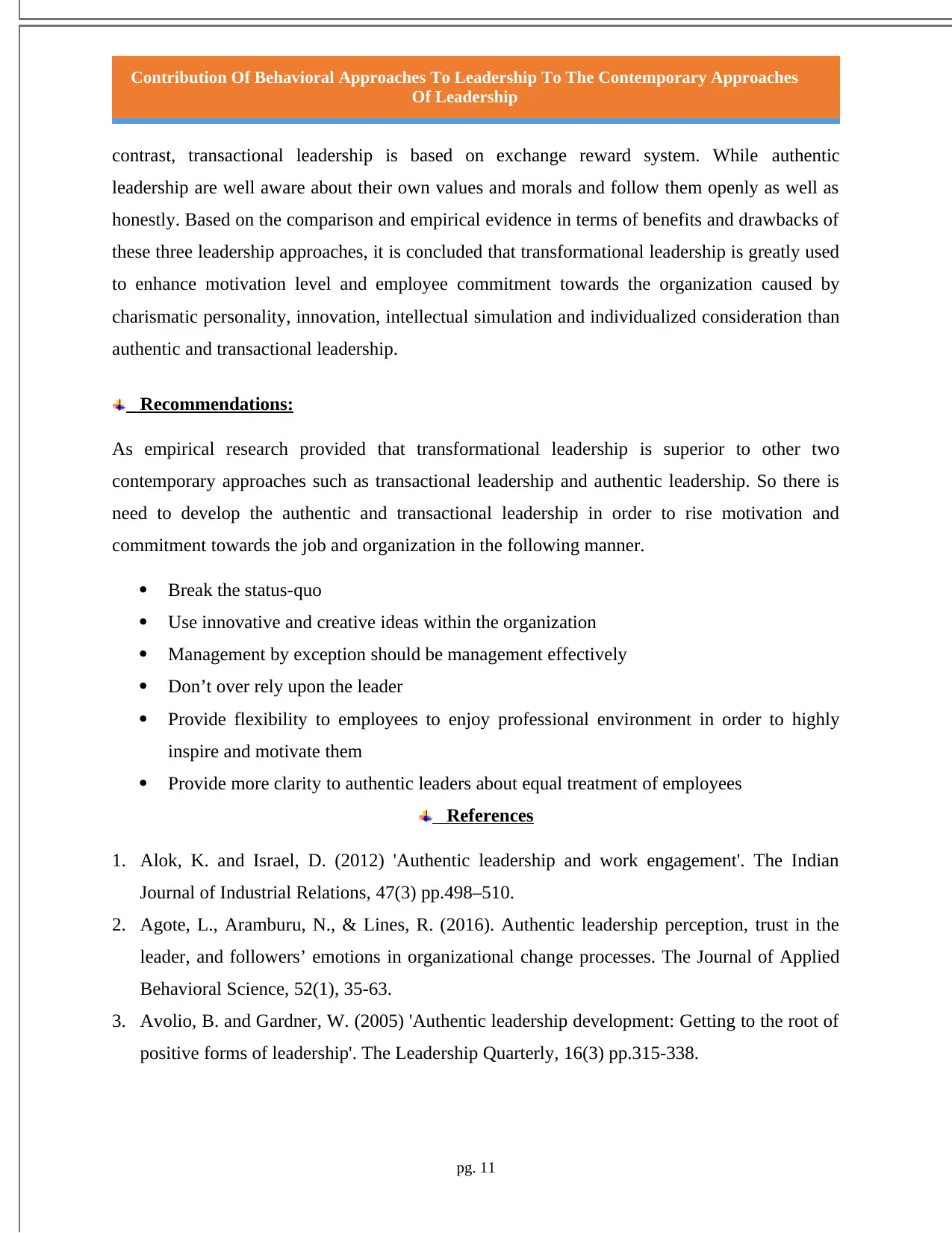
Contribution Of Behavioral Approaches To Leadership To The Contemporary Approaches
Of Leadership
contrast, transactional leadership is based on exchange reward system. While authentic
leadership are well aware about their own values and morals and follow them openly as well as
honestly. Based on the comparison and empirical evidence in terms of benefits and drawbacks of
these three leadership approaches, it is concluded that transformational leadership is greatly used
to enhance motivation level and employee commitment towards the organization caused by
charismatic personality, innovation, intellectual simulation and individualized consideration than
authentic and transactional leadership.
Recommendations:
As empirical research provided that transformational leadership is superior to other two
contemporary approaches such as transactional leadership and authentic leadership. So there is
need to develop the authentic and transactional leadership in order to rise motivation and
commitment towards the job and organization in the following manner.
Break the status-quo
Use innovative and creative ideas within the organization
Management by exception should be management effectively
Don’t over rely upon the leader
Provide flexibility to employees to enjoy professional environment in order to highly
inspire and motivate them
Provide more clarity to authentic leaders about equal treatment of employees
References
1. Alok, K. and Israel, D. (2012) 'Authentic leadership and work engagement'. The Indian
Journal of Industrial Relations, 47(3) pp.498–510.
2. Agote, L., Aramburu, N., & Lines, R. (2016). Authentic leadership perception, trust in the
leader, and followers’ emotions in organizational change processes. The Journal of Applied
Behavioral Science, 52(1), 35-63.
3. Avolio, B. and Gardner, W. (2005) 'Authentic leadership development: Getting to the root of
positive forms of leadership'. The Leadership Quarterly, 16(3) pp.315-338.
pg. 11
Of Leadership
contrast, transactional leadership is based on exchange reward system. While authentic
leadership are well aware about their own values and morals and follow them openly as well as
honestly. Based on the comparison and empirical evidence in terms of benefits and drawbacks of
these three leadership approaches, it is concluded that transformational leadership is greatly used
to enhance motivation level and employee commitment towards the organization caused by
charismatic personality, innovation, intellectual simulation and individualized consideration than
authentic and transactional leadership.
Recommendations:
As empirical research provided that transformational leadership is superior to other two
contemporary approaches such as transactional leadership and authentic leadership. So there is
need to develop the authentic and transactional leadership in order to rise motivation and
commitment towards the job and organization in the following manner.
Break the status-quo
Use innovative and creative ideas within the organization
Management by exception should be management effectively
Don’t over rely upon the leader
Provide flexibility to employees to enjoy professional environment in order to highly
inspire and motivate them
Provide more clarity to authentic leaders about equal treatment of employees
References
1. Alok, K. and Israel, D. (2012) 'Authentic leadership and work engagement'. The Indian
Journal of Industrial Relations, 47(3) pp.498–510.
2. Agote, L., Aramburu, N., & Lines, R. (2016). Authentic leadership perception, trust in the
leader, and followers’ emotions in organizational change processes. The Journal of Applied
Behavioral Science, 52(1), 35-63.
3. Avolio, B. and Gardner, W. (2005) 'Authentic leadership development: Getting to the root of
positive forms of leadership'. The Leadership Quarterly, 16(3) pp.315-338.
pg. 11
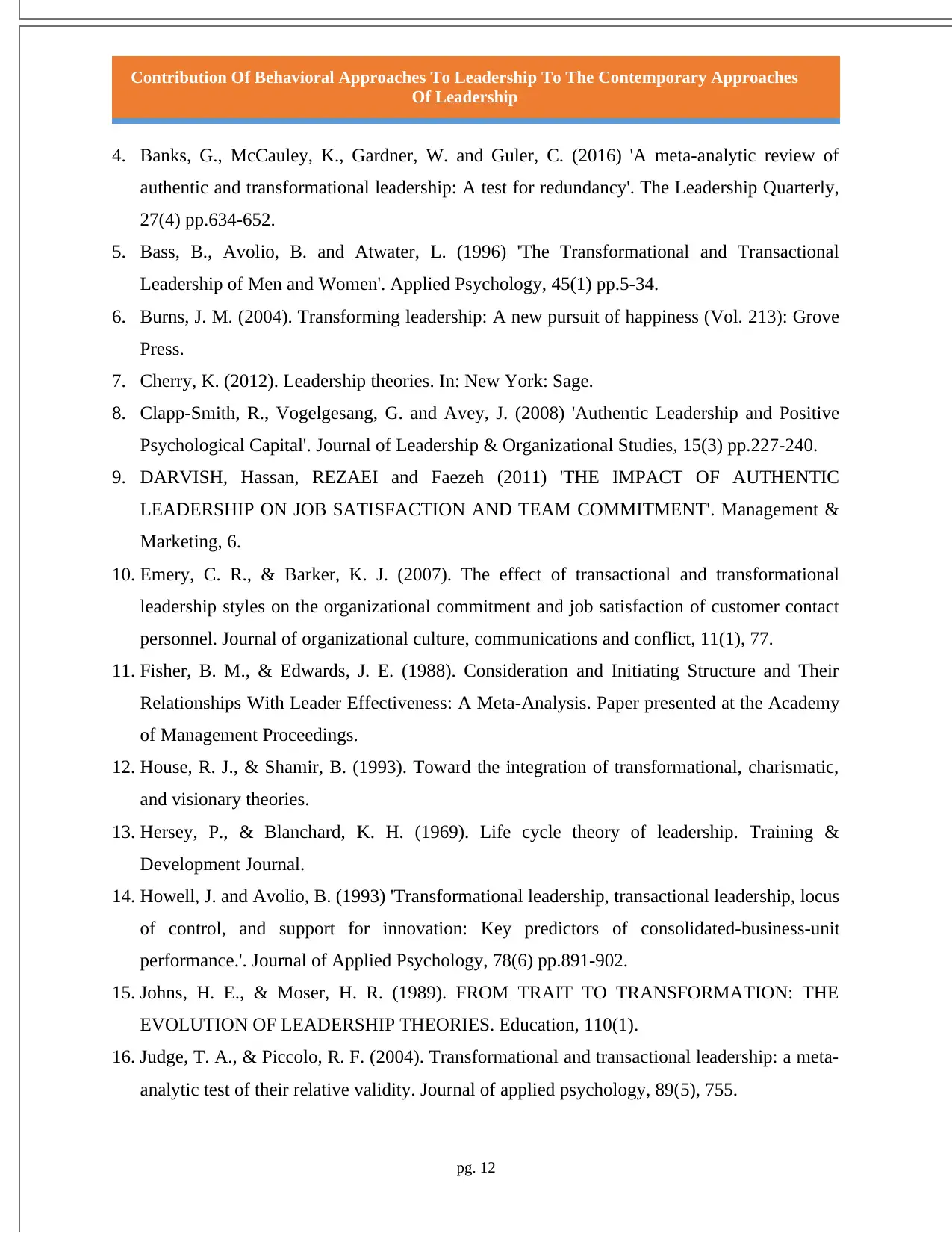
Contribution Of Behavioral Approaches To Leadership To The Contemporary Approaches
Of Leadership
4. Banks, G., McCauley, K., Gardner, W. and Guler, C. (2016) 'A meta-analytic review of
authentic and transformational leadership: A test for redundancy'. The Leadership Quarterly,
27(4) pp.634-652.
5. Bass, B., Avolio, B. and Atwater, L. (1996) 'The Transformational and Transactional
Leadership of Men and Women'. Applied Psychology, 45(1) pp.5-34.
6. Burns, J. M. (2004). Transforming leadership: A new pursuit of happiness (Vol. 213): Grove
Press.
7. Cherry, K. (2012). Leadership theories. In: New York: Sage.
8. Clapp-Smith, R., Vogelgesang, G. and Avey, J. (2008) 'Authentic Leadership and Positive
Psychological Capital'. Journal of Leadership & Organizational Studies, 15(3) pp.227-240.
9. DARVISH, Hassan, REZAEI and Faezeh (2011) 'THE IMPACT OF AUTHENTIC
LEADERSHIP ON JOB SATISFACTION AND TEAM COMMITMENT'. Management &
Marketing, 6.
10. Emery, C. R., & Barker, K. J. (2007). The effect of transactional and transformational
leadership styles on the organizational commitment and job satisfaction of customer contact
personnel. Journal of organizational culture, communications and conflict, 11(1), 77.
11. Fisher, B. M., & Edwards, J. E. (1988). Consideration and Initiating Structure and Their
Relationships With Leader Effectiveness: A Meta-Analysis. Paper presented at the Academy
of Management Proceedings.
12. House, R. J., & Shamir, B. (1993). Toward the integration of transformational, charismatic,
and visionary theories.
13. Hersey, P., & Blanchard, K. H. (1969). Life cycle theory of leadership. Training &
Development Journal.
14. Howell, J. and Avolio, B. (1993) 'Transformational leadership, transactional leadership, locus
of control, and support for innovation: Key predictors of consolidated-business-unit
performance.'. Journal of Applied Psychology, 78(6) pp.891-902.
15. Johns, H. E., & Moser, H. R. (1989). FROM TRAIT TO TRANSFORMATION: THE
EVOLUTION OF LEADERSHIP THEORIES. Education, 110(1).
16. Judge, T. A., & Piccolo, R. F. (2004). Transformational and transactional leadership: a meta-
analytic test of their relative validity. Journal of applied psychology, 89(5), 755.
pg. 12
Of Leadership
4. Banks, G., McCauley, K., Gardner, W. and Guler, C. (2016) 'A meta-analytic review of
authentic and transformational leadership: A test for redundancy'. The Leadership Quarterly,
27(4) pp.634-652.
5. Bass, B., Avolio, B. and Atwater, L. (1996) 'The Transformational and Transactional
Leadership of Men and Women'. Applied Psychology, 45(1) pp.5-34.
6. Burns, J. M. (2004). Transforming leadership: A new pursuit of happiness (Vol. 213): Grove
Press.
7. Cherry, K. (2012). Leadership theories. In: New York: Sage.
8. Clapp-Smith, R., Vogelgesang, G. and Avey, J. (2008) 'Authentic Leadership and Positive
Psychological Capital'. Journal of Leadership & Organizational Studies, 15(3) pp.227-240.
9. DARVISH, Hassan, REZAEI and Faezeh (2011) 'THE IMPACT OF AUTHENTIC
LEADERSHIP ON JOB SATISFACTION AND TEAM COMMITMENT'. Management &
Marketing, 6.
10. Emery, C. R., & Barker, K. J. (2007). The effect of transactional and transformational
leadership styles on the organizational commitment and job satisfaction of customer contact
personnel. Journal of organizational culture, communications and conflict, 11(1), 77.
11. Fisher, B. M., & Edwards, J. E. (1988). Consideration and Initiating Structure and Their
Relationships With Leader Effectiveness: A Meta-Analysis. Paper presented at the Academy
of Management Proceedings.
12. House, R. J., & Shamir, B. (1993). Toward the integration of transformational, charismatic,
and visionary theories.
13. Hersey, P., & Blanchard, K. H. (1969). Life cycle theory of leadership. Training &
Development Journal.
14. Howell, J. and Avolio, B. (1993) 'Transformational leadership, transactional leadership, locus
of control, and support for innovation: Key predictors of consolidated-business-unit
performance.'. Journal of Applied Psychology, 78(6) pp.891-902.
15. Johns, H. E., & Moser, H. R. (1989). FROM TRAIT TO TRANSFORMATION: THE
EVOLUTION OF LEADERSHIP THEORIES. Education, 110(1).
16. Judge, T. A., & Piccolo, R. F. (2004). Transformational and transactional leadership: a meta-
analytic test of their relative validity. Journal of applied psychology, 89(5), 755.
pg. 12
Paraphrase This Document
Need a fresh take? Get an instant paraphrase of this document with our AI Paraphraser
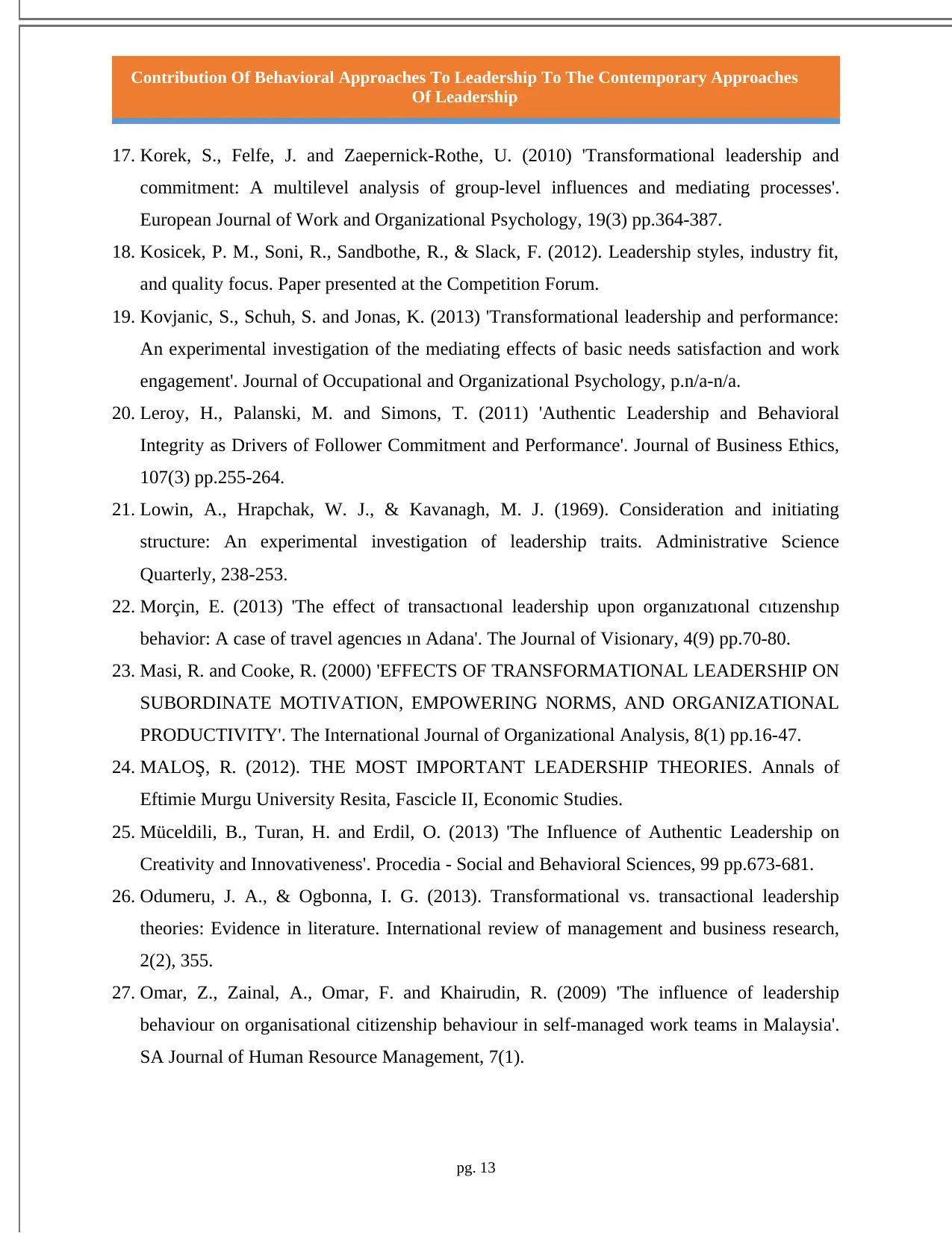
Contribution Of Behavioral Approaches To Leadership To The Contemporary Approaches
Of Leadership
17. Korek, S., Felfe, J. and Zaepernick-Rothe, U. (2010) 'Transformational leadership and
commitment: A multilevel analysis of group-level influences and mediating processes'.
European Journal of Work and Organizational Psychology, 19(3) pp.364-387.
18. Kosicek, P. M., Soni, R., Sandbothe, R., & Slack, F. (2012). Leadership styles, industry fit,
and quality focus. Paper presented at the Competition Forum.
19. Kovjanic, S., Schuh, S. and Jonas, K. (2013) 'Transformational leadership and performance:
An experimental investigation of the mediating effects of basic needs satisfaction and work
engagement'. Journal of Occupational and Organizational Psychology, p.n/a-n/a.
20. Leroy, H., Palanski, M. and Simons, T. (2011) 'Authentic Leadership and Behavioral
Integrity as Drivers of Follower Commitment and Performance'. Journal of Business Ethics,
107(3) pp.255-264.
21. Lowin, A., Hrapchak, W. J., & Kavanagh, M. J. (1969). Consideration and initiating
structure: An experimental investigation of leadership traits. Administrative Science
Quarterly, 238-253.
22. Morçin, E. (2013) 'The effect of transactıonal leadership upon organızatıonal cıtızenshıp
behavior: A case of travel agencıes ın Adana'. The Journal of Visionary, 4(9) pp.70-80.
23. Masi, R. and Cooke, R. (2000) 'EFFECTS OF TRANSFORMATIONAL LEADERSHIP ON
SUBORDINATE MOTIVATION, EMPOWERING NORMS, AND ORGANIZATIONAL
PRODUCTIVITY'. The International Journal of Organizational Analysis, 8(1) pp.16-47.
24. MALOŞ, R. (2012). THE MOST IMPORTANT LEADERSHIP THEORIES. Annals of
Eftimie Murgu University Resita, Fascicle II, Economic Studies.
25. Müceldili, B., Turan, H. and Erdil, O. (2013) 'The Influence of Authentic Leadership on
Creativity and Innovativeness'. Procedia - Social and Behavioral Sciences, 99 pp.673-681.
26. Odumeru, J. A., & Ogbonna, I. G. (2013). Transformational vs. transactional leadership
theories: Evidence in literature. International review of management and business research,
2(2), 355.
27. Omar, Z., Zainal, A., Omar, F. and Khairudin, R. (2009) 'The influence of leadership
behaviour on organisational citizenship behaviour in self-managed work teams in Malaysia'.
SA Journal of Human Resource Management, 7(1).
pg. 13
Of Leadership
17. Korek, S., Felfe, J. and Zaepernick-Rothe, U. (2010) 'Transformational leadership and
commitment: A multilevel analysis of group-level influences and mediating processes'.
European Journal of Work and Organizational Psychology, 19(3) pp.364-387.
18. Kosicek, P. M., Soni, R., Sandbothe, R., & Slack, F. (2012). Leadership styles, industry fit,
and quality focus. Paper presented at the Competition Forum.
19. Kovjanic, S., Schuh, S. and Jonas, K. (2013) 'Transformational leadership and performance:
An experimental investigation of the mediating effects of basic needs satisfaction and work
engagement'. Journal of Occupational and Organizational Psychology, p.n/a-n/a.
20. Leroy, H., Palanski, M. and Simons, T. (2011) 'Authentic Leadership and Behavioral
Integrity as Drivers of Follower Commitment and Performance'. Journal of Business Ethics,
107(3) pp.255-264.
21. Lowin, A., Hrapchak, W. J., & Kavanagh, M. J. (1969). Consideration and initiating
structure: An experimental investigation of leadership traits. Administrative Science
Quarterly, 238-253.
22. Morçin, E. (2013) 'The effect of transactıonal leadership upon organızatıonal cıtızenshıp
behavior: A case of travel agencıes ın Adana'. The Journal of Visionary, 4(9) pp.70-80.
23. Masi, R. and Cooke, R. (2000) 'EFFECTS OF TRANSFORMATIONAL LEADERSHIP ON
SUBORDINATE MOTIVATION, EMPOWERING NORMS, AND ORGANIZATIONAL
PRODUCTIVITY'. The International Journal of Organizational Analysis, 8(1) pp.16-47.
24. MALOŞ, R. (2012). THE MOST IMPORTANT LEADERSHIP THEORIES. Annals of
Eftimie Murgu University Resita, Fascicle II, Economic Studies.
25. Müceldili, B., Turan, H. and Erdil, O. (2013) 'The Influence of Authentic Leadership on
Creativity and Innovativeness'. Procedia - Social and Behavioral Sciences, 99 pp.673-681.
26. Odumeru, J. A., & Ogbonna, I. G. (2013). Transformational vs. transactional leadership
theories: Evidence in literature. International review of management and business research,
2(2), 355.
27. Omar, Z., Zainal, A., Omar, F. and Khairudin, R. (2009) 'The influence of leadership
behaviour on organisational citizenship behaviour in self-managed work teams in Malaysia'.
SA Journal of Human Resource Management, 7(1).
pg. 13
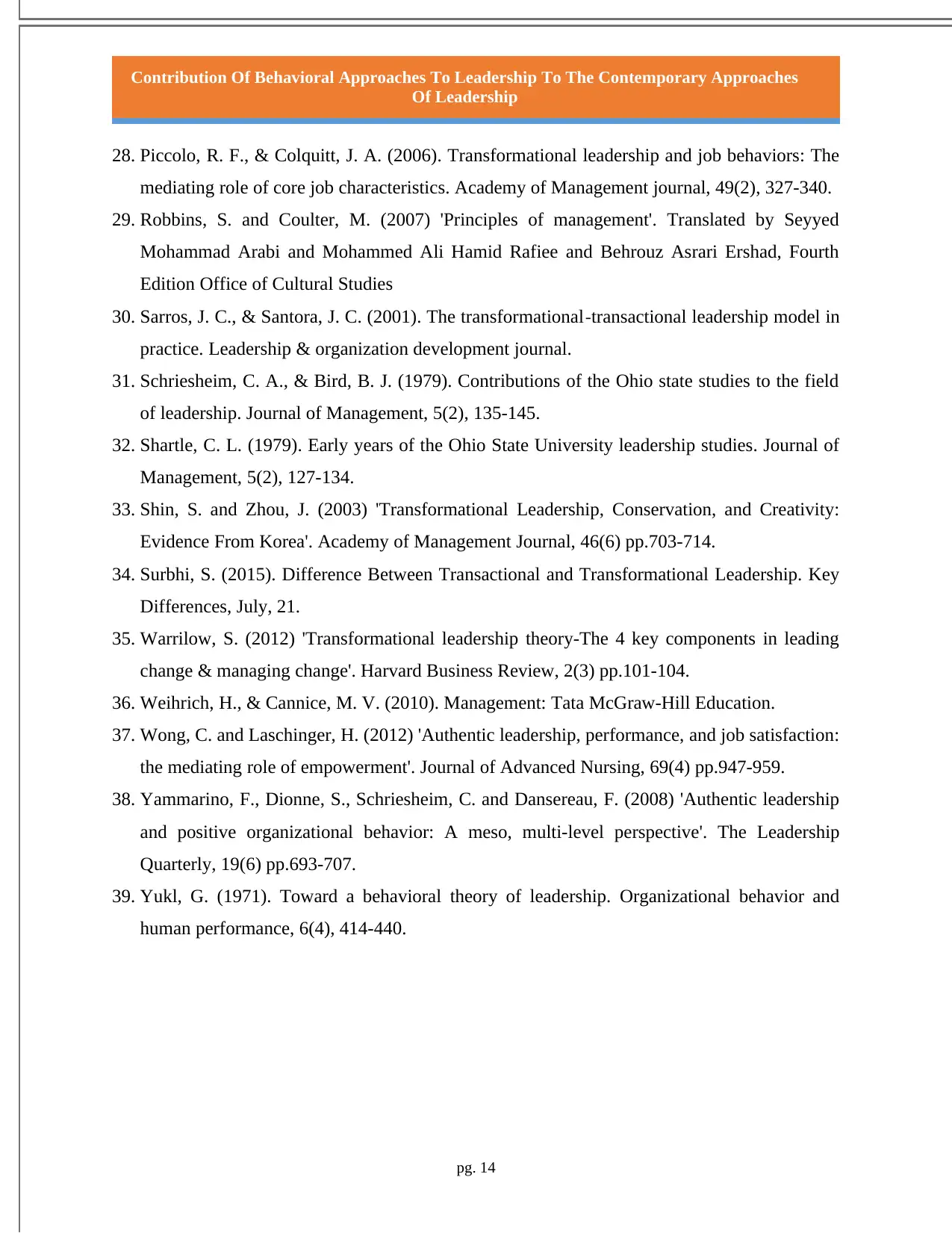
Contribution Of Behavioral Approaches To Leadership To The Contemporary Approaches
Of Leadership
28. Piccolo, R. F., & Colquitt, J. A. (2006). Transformational leadership and job behaviors: The
mediating role of core job characteristics. Academy of Management journal, 49(2), 327-340.
29. Robbins, S. and Coulter, M. (2007) 'Principles of management'. Translated by Seyyed
Mohammad Arabi and Mohammed Ali Hamid Rafiee and Behrouz Asrari Ershad, Fourth
Edition Office of Cultural Studies
30. Sarros, J. C., & Santora, J. C. (2001). The transformational‐transactional leadership model in
practice. Leadership & organization development journal.
31. Schriesheim, C. A., & Bird, B. J. (1979). Contributions of the Ohio state studies to the field
of leadership. Journal of Management, 5(2), 135-145.
32. Shartle, C. L. (1979). Early years of the Ohio State University leadership studies. Journal of
Management, 5(2), 127-134.
33. Shin, S. and Zhou, J. (2003) 'Transformational Leadership, Conservation, and Creativity:
Evidence From Korea'. Academy of Management Journal, 46(6) pp.703-714.
34. Surbhi, S. (2015). Difference Between Transactional and Transformational Leadership. Key
Differences, July, 21.
35. Warrilow, S. (2012) 'Transformational leadership theory-The 4 key components in leading
change & managing change'. Harvard Business Review, 2(3) pp.101-104.
36. Weihrich, H., & Cannice, M. V. (2010). Management: Tata McGraw-Hill Education.
37. Wong, C. and Laschinger, H. (2012) 'Authentic leadership, performance, and job satisfaction:
the mediating role of empowerment'. Journal of Advanced Nursing, 69(4) pp.947-959.
38. Yammarino, F., Dionne, S., Schriesheim, C. and Dansereau, F. (2008) 'Authentic leadership
and positive organizational behavior: A meso, multi-level perspective'. The Leadership
Quarterly, 19(6) pp.693-707.
39. Yukl, G. (1971). Toward a behavioral theory of leadership. Organizational behavior and
human performance, 6(4), 414-440.
pg. 14
Of Leadership
28. Piccolo, R. F., & Colquitt, J. A. (2006). Transformational leadership and job behaviors: The
mediating role of core job characteristics. Academy of Management journal, 49(2), 327-340.
29. Robbins, S. and Coulter, M. (2007) 'Principles of management'. Translated by Seyyed
Mohammad Arabi and Mohammed Ali Hamid Rafiee and Behrouz Asrari Ershad, Fourth
Edition Office of Cultural Studies
30. Sarros, J. C., & Santora, J. C. (2001). The transformational‐transactional leadership model in
practice. Leadership & organization development journal.
31. Schriesheim, C. A., & Bird, B. J. (1979). Contributions of the Ohio state studies to the field
of leadership. Journal of Management, 5(2), 135-145.
32. Shartle, C. L. (1979). Early years of the Ohio State University leadership studies. Journal of
Management, 5(2), 127-134.
33. Shin, S. and Zhou, J. (2003) 'Transformational Leadership, Conservation, and Creativity:
Evidence From Korea'. Academy of Management Journal, 46(6) pp.703-714.
34. Surbhi, S. (2015). Difference Between Transactional and Transformational Leadership. Key
Differences, July, 21.
35. Warrilow, S. (2012) 'Transformational leadership theory-The 4 key components in leading
change & managing change'. Harvard Business Review, 2(3) pp.101-104.
36. Weihrich, H., & Cannice, M. V. (2010). Management: Tata McGraw-Hill Education.
37. Wong, C. and Laschinger, H. (2012) 'Authentic leadership, performance, and job satisfaction:
the mediating role of empowerment'. Journal of Advanced Nursing, 69(4) pp.947-959.
38. Yammarino, F., Dionne, S., Schriesheim, C. and Dansereau, F. (2008) 'Authentic leadership
and positive organizational behavior: A meso, multi-level perspective'. The Leadership
Quarterly, 19(6) pp.693-707.
39. Yukl, G. (1971). Toward a behavioral theory of leadership. Organizational behavior and
human performance, 6(4), 414-440.
pg. 14
1 out of 15
Related Documents
Your All-in-One AI-Powered Toolkit for Academic Success.
+13062052269
info@desklib.com
Available 24*7 on WhatsApp / Email
![[object Object]](/_next/static/media/star-bottom.7253800d.svg)
Unlock your academic potential
© 2024 | Zucol Services PVT LTD | All rights reserved.





